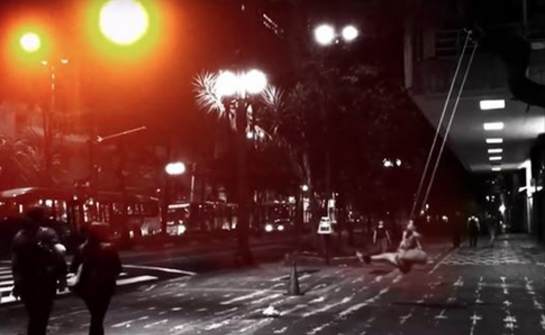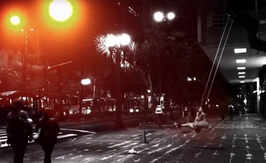The register of the fleeting moments of the daily life
Abilio Guerra
In 1982, the feature film Koyaanisqatsi was released, directed by Godfrey Reggio. It’s atmosphere mixes the epic and the sacred, human and natural world intertwined, seen from a high, even exaggerated vantage point. As in Ran, by Akira Kurosawa, it brings a divine point of view, watching everything with intent curiosity, but from a distance and without any emotional link; afterall, the observer knows exactly where everything is going to end up.
Endless canyons and mountain clusters, waterfalls with inconceivable highs and big-scale human hives, hundreds of thousands walking along humongous avenues, mountains shadows and granite, rough and polished – everything evokes a transcendent magniloquence. The urban and natural shots are shown alternating in the screen, but also fusing in scenes where the tempest clouds are duplicated on the mirrored facades of the huge steel or concrete towers. The magnificent music, by Philip Glass, encompasses the scenery with its numbing melody, its hypnotizing mantra, endlessly repeating the magic word – Koyaanisqatsi, Koyaanisqatsi...
The solemnity of Reggios movie came to me, as a counterpoint, when I watched the short film Quimpassi, made by Irmãos Guerra (a duo of Brazilian video-making siblings). Second video art made for the Ponte project – concocted in Italy by Giovanni Pirelli and Ludovico Schilling –, its theme song is a remix made by Doomy, a collective of Italian electronic music producers set in London, from the original music, also named Quimpassi, composed by Guilherme Giraldi and originally recorded by the band Charlie e os Marretas.
At first, everything in Quimpassi works as the extreme opposite of what you see in Koyaanisqatsi. The time distended to the eternity we have in the latter is replaced in the former by the pace-maker of the daily life; the transcendent vision of he who sees everything without being seen in turn gives way to the immanent vision, which interacts with the situations, where the watchers own body can be seen in feet walking by grass or concrete, in hands that carry ice-cream or hold on to a bicycle handlebar. Those are the bodies of who record daily with cellphones cameras; those are bodies that walk through human territory, taking advantage of a human temporality.
This way of looking transfigures the things of the world in things of the men, seized by human use, by the feelings and desires that are shared and divided by everyone, between everyone. Sites set apart by huge distances become a single place, home to the sensorial experience of those who observe the world. The distant times – the cellphone footage was produced over many years – couple seamlessly in a single timeline experienced by a weird collective entity. That way, times and places are put together without any kind of hierarchy or causal order. A girl records herself swinging in a European park, a young man – magically transmuted in a child – is recorded while swinging in downtown São Paulo. Araraquara, a small town in the outskirts of São Paulo, is worth just as much as Berlin; Brasília, Budapest and Busca Vida are indistinguishably stimulating; London, Mértola, Moscow, Potsdam, Porto, Saint Petersburg and Venice are just as familiar as Tiradentes, Salvador, Jaú, Monte Verde, Ouro Preto and Chapada dos Veadeiros are strange. In order for you to play the music and start dancing, anywhere goes, any time is a good time.
A thin layer of an almost oneiric liquid seems to be laid upon the images that show the eternal coming and going to and from of men and women, old people and children, and of everything that surrounds them and deserves their affection – kitties playing, ice-creams that are eaten, bicycles that are cycled, boats and trains filled to the brim with even more people. If Koyaanisqatsi is a great work of art that searches for the holiness of eternity by means of a vision from above, Quimpassi is an aesthetical experiment that runs in the elusive divine manifestation behind each and every human act. Instead of the magnificent sublime, we have but the wonder.
Datasheet
work
Quimpassi is the second chapter of Ponte project, devised by Giovanni Pirelli and Ludovico Schilling and that promotes the dialogue and experience exchange between international artists.
domain
http://www.projetoponte.com/ponteproj-en.html
shot, directed and edited by
Irmãos Guerra
composed by
Guilherme Giraldi
original recording
Charles Tixier (drums), Guilherme Giraldi (bass), André Vac (guitar), Tomás de Souza (keyboard), Gabriel Basile (percussion) and Rafael Molina (sax)
remixing by
Doomy (Ludovico Schilling, Mattia Veronese, Paolo Pacucci) – remix
Marco Zangirolami – master
about the author
Abilio Guerra is a post-graduation teacher in FAU Mackenzie and editor, along with Silvana Romano Santos, of portal Vitruvius and Romano Guerra Editora.






